1962 Monaco Grand Prix race report: Kiwi survives hunting red shark
Bruce McLaren 1st out of only five finishers as Cooper driver survives late charge of Phil Hill
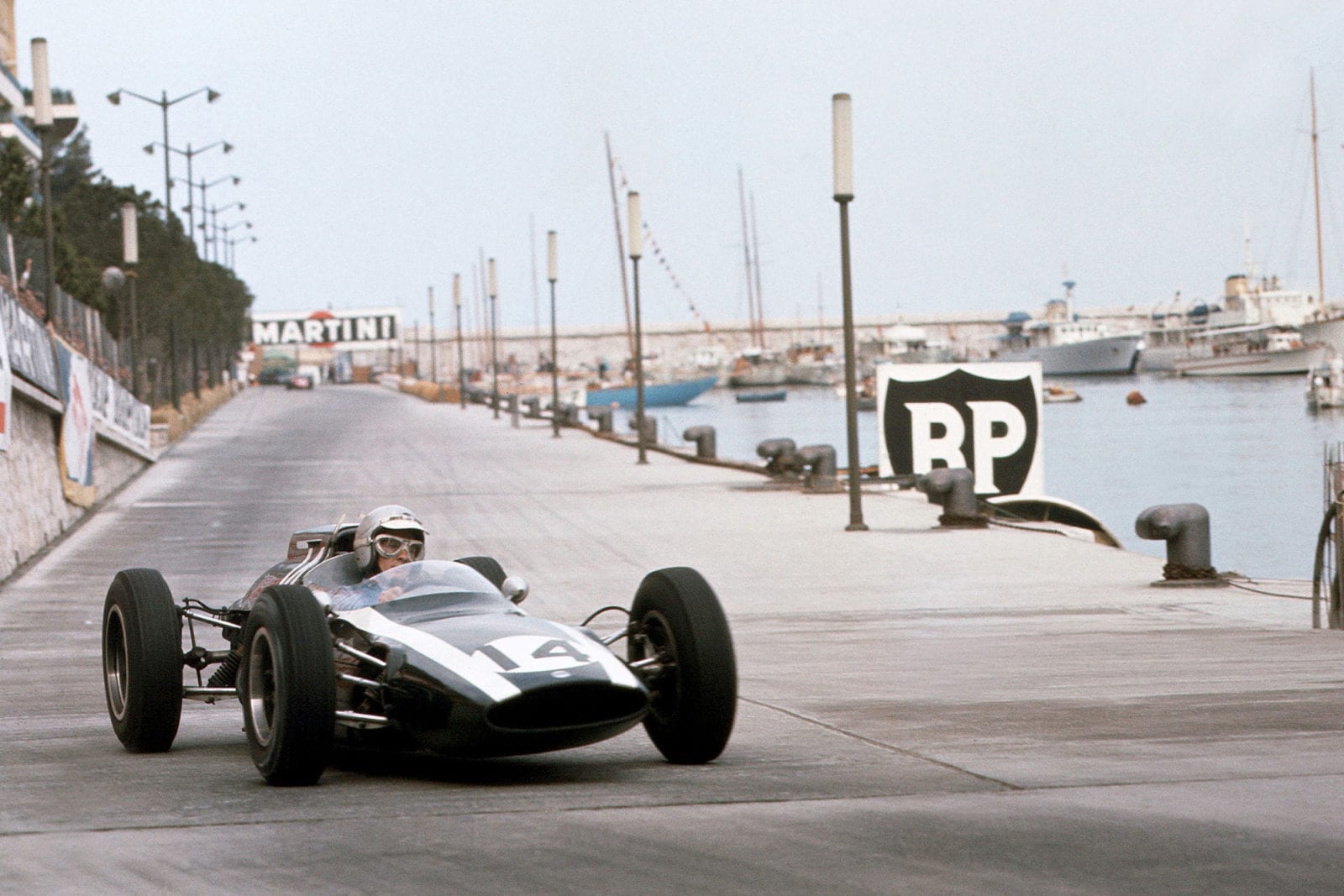
McLaren took his 3rd career win on the streets of Monaco
Motorsport Images
Due to a shuffling of the calendar this year the Monaco GP was not the first Grande Epreuve, the Dutch GP already having been held, so that everyone arrived in the Principality ready to do battle, this year’s form having been indicated at Zandvoort, where BRM ran away with the race. Once again the entry of 16 cars for the Monaco race was decided by ten invitations and six qualifiers from the remainder of the entry of 23. As Marsh (BRM V8) and Businello (de Tomaso) did not appear this automatically reduced the qualifiers to eleven.
Invited entries were two each from Porsche, BRM, Cooper, Lotus and Ferrari; these drivers being Bonnier, Gurney, Hill, Ginther, McLaren, Maggs, Clark, Taylor and P Hill, the second Ferrari being nominated as “X”. To qualify were Brabham (Lotus-Climax V8), Trintignant (Lotus-Climax V8), Lewis (BRM V8), Salvadori and Surtees (Lola-Climax V8), Gregory (Lotus-BRM V8), Ireland (Lotus-Climax V8), Vaccarella (Lotus-Climax 4), de Beaufort (Porsche 4), Siffert (Lotus-Climax 4), and either Bandini or Mairesse (Ferrari), whichever was not nominated for “X”. In addition R. Rodriguez was present with a training Ferrari.
As can be appreciated the quality of the “also rans” was as high as the invited list and it seemed unreasonable that Bonnier and Maggs should not have to qualify as they were both in obsolete cars, though officially works drivers. After Zandvoort, Porsche went home and decided to give Monaco a miss, as they had been disappointed with the performance of the new 8-cylinder cars, but after the way the 2-litre 8-cylinder cars had performed in the 1,000 kilometres at Nurburgring they had second thoughts.
Gurney and Hanstein were all for racing the new cars no matter how they performed, and after a long struggle won the day and got one 8-cylinder car for Gurney to drive. Bonnier was relegated to an old 4-cylinder car, the red one from the Scuderia Venezia, which Porsche fettled-up for the occasion.
John Cooper naturally entered his two works drivers, McLaren on the lone Cooper V8 and Maggs with last year’s 4-cylinder car. In a race limited to only 16 cars, and with such a galaxy of talent waiting to qualify with brand new machinery, it was wrong that two drivers with obsolete cars that might well get in the way of the fast stuff should be guaranteed entries just because the factories nominated them. But Monaco was always tainted with a touch of comic-opera.
Qualifying
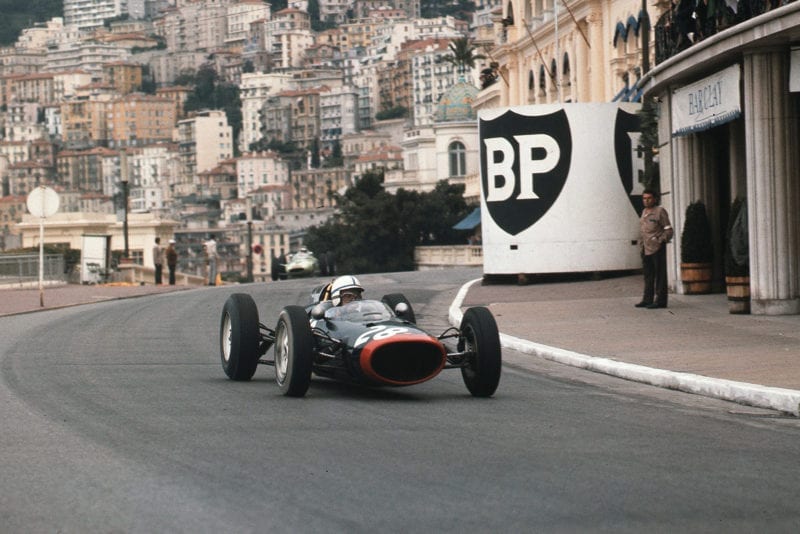
Surtees recovered from his Zandvort crash to qualify 10th
Motorsport Images
Practice began at a very reasonable hour on Thursday afternoon in warm and dry conditions, and Gurney arrived back from Indianapolis just in time to take out the lone 8-cylinder Porsche. The pit area was full of interest and excitement, UDT-Laystall having two new Lotus 24 models, one with the V8 Coventry-Climax from the car Ireland crashed at Zandvoort, and the other with a new V8 BRM engine, both cars using 5-speed Colotti gearboxes.
Ireland was in the first car and Gregory in the second, the BRM engine using Weber carburetters and short stub exhaust pipes entirely unsupported; they also had an old 4-cylinder Lotus as a spare. Another new car was the Rob Walker entry for Trintignant, being a Lotus 24 with Coventry-Climax V8 engine, and as a precaution they had the old 4-cylinder Lotus with them that Trintignant had used to win at Pau. BRM had a brand new car for Ginther, this being to 1962 pattern but having a 6-speed Colotti gearbox as an experiment, and downswept exhaust pipes feeding into large-diameter tail-pipes mounted under the rear suspension.
“The nose cowling on the BRM was especially shortened for Monaco street brawls’”
The nose cowling on this car was especially shortened for Monaco “street brawls” and Graham Hill’s car, which was his Zandvoort-winning car, had also had the nose cowling cut down. As a spare they had the 1961/62 chassis car that Ginther had driven at Zandvoort, all three cars being on fuel injection. Jack Lewis was running his V8 BRM as a private entry, though Marsh had been entered by the Owen Racing Organisation, but it seemed he had no intention of turning up.
The Bowmaker team of Lolas were as at Zandvoort, with Surtees and Salvadori, except that the Surtees car now had tubular top suspension arms on the front in place of the U-section ones, and the geometry of the rear end had been altered. Yeoman Credit have apparently dropped out of the running so that it is now the Bowmaker HP team, but the personnel remains the same and the cars still use Coventry-Climax V8 engines and Colotti gearboxes, and both cars had short, blunt nose cowlings. The Team Lotus drivers had the same cars as at Zandvoort, Clark with the “monocoque” Type 25 and Taylor with the more orthodox Type 24, both with Coventry-Climax V8 engines and ZF gearboxes.
Brabham was still running his bright green Lotus 24 with Climax V8 engine, there being no sign of the Brabham car as yet, though some of his Juniors were entered for the Monaco Junior race. There was a galaxy of Ferraris entered by the factory. Hill, Bandini and Mairesse had 120-degree V6-engined cars as raced at Zandvoort, except that all three were using the wide rear wishbones tried out by Hill in Holland, but the top spring anchorages were of the close-in old pattern, so that the coil-springs were inclined more steeply. As a spare car there was an old 65-degree V6-engined car, which Rodriguez drove. Finally there were two private owners, de Beaufort with his old 4-cylinder Porsche and Siffert with his Lotus-Climax 4-cylinder.
Last year the fastest lap in the race had been a scorching 1min 36.3sec recorded by Moss and Ginther in the heat of their battle, whereas best practice time had been only 1min 39.1sec, so it was reasonable to suppose that anyone worthwhile would get below 1min 40sec and the faster drivers would approach 1min 36sec. The BRM team were very confident and Graham Hill was soon out and setting the pace, but Clark was hot on his heels, and Surtees was having a real try even though the Lola was not handling perfectly, but it was definitely showing improvement.
Gurney was well under the 1min 40sec mark, thus encouraging Porsche, and Phil Hill was setting the pace for the Ferrari team, his full-opposite lock slides with the power well on round the Gasworks hairpin were reminiscent of Fangio in his heyday with the 250F Maserati. The BRM and Lotus drivers, taking more orthodox lines, were having to wait until the understeer dissipated itself before opening up their V8 engines. Ginther was not at all happy with the new BRM and was in continual trouble with the throttles not opening smoothly. The Lucas injection system uses a sliding plate throttle for each bank of four inlet pipes and a heavy pressure is needed on the pedal to overcome the friction.
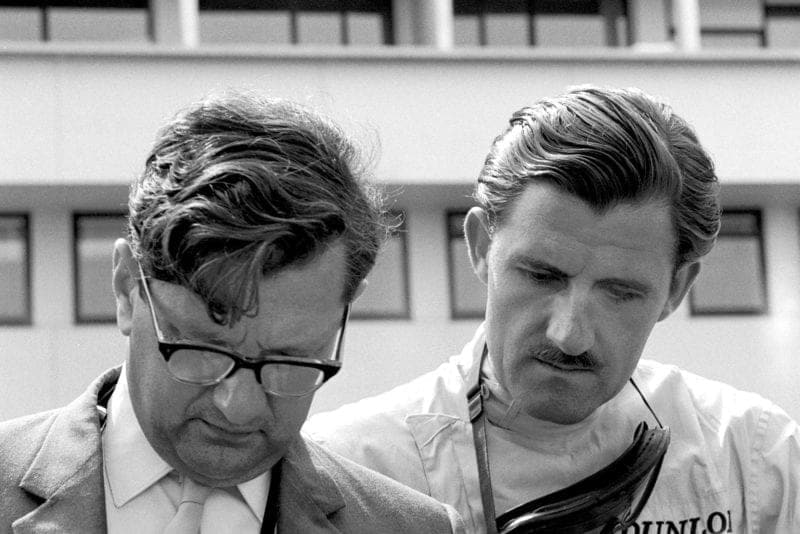
BRM’s Graham Hill and Tony Rudd prepare for the race
Motorsport Images
Graham Hill was not having this trouble, presumably because he has bigger and heavier feet than the diminutive Ginther! The high-revving and nervous V8 engines certainly call for some delicate throttle control at times. The two UDT-Laystall cars were showing almost identical lap times, but as the Climax V8 car had only recently been assembled and there had been no time to get adjustments spot on, and the BRM V8-engined car was out for the first time and was an entirely unknown quantity, nothing very much could be concluded.
While more people were below 1min 40sec than were expected in this first practice, the fastest were not as close to 1min 36sec as anticipated. However, the results and general pace were good, as the accompanying table shows, and the battle for the all-important starting-grid positions was well under way, with Clark and Graham Hill heading the list. With practice ending at 3:30pm and the next session due on the following morning at 7:15am there was not much respite for the mechanics, but unlike last year there were no major prangs to straighten out, for all the drivers had behaved themselves.
Almost unbelievable for Monte Carlo, rain was falling before practice began on Friday morning, and it continued to fall for most of the day. As a practice period it was a washout in more ways than one, and at times the rain was so heavy that it was bouncing off the road. Team Lotus had brought out a new car, this being a Type 24 with BRM V8 engine and Colotti 6-speed gearbox, and though both Clark and Taylor tried the car there was no hope of learning anything.
Brabham was in trouble with a water-logged engine and never did get started, and the only man who looked quite happy and unperturbed by the conditions was Graham Hill, who was going round very smoothly in the BRM. Siffert was also driving very nicely in the wet and, oddly enough, all the Ferraris were going well. There was a new Ferrari at the pits, with the 1962 chassis having the 6-speed gearbox in between the engine and the back axle, though it still had the old 120-degree V6 engine. Phil Hill did but one lap in this car.
Mairesse was fastest of the Maranello drivers, he being the only one to get below 2min and join Graham Hill (BRM) in the under-2-min group. Vaccarella was out for the first time, in the Venezia Lotus-Climax 4-cylinder, and it also proved to be his last outing, for after keeping up with Bandini for a number of laps he spun and bent the Lotus badly. Practice finished at 9am and most people spent the rest of the day trying to dry out, while for once mechanics had plenty of time for checking and servicing as the final practice was not due until 2pm on Saturday afternoon.
“Everyone came out with a rush and roar on Saturday afternoon and the pandemonium and excitement was terrific”
After the frustrations of Friday practice everyone came out with a rush and roar on Saturday afternoon and the pandemonium and excitement was terrific; the weather was perfect and everyone was out to improve their position on the grid or qualify among the also-rans. Lotus were involved in some film making and lost valuable time, while Graham Hill got on with the job and soon set FTD with a lap in 1min 35.8sec, which was more like what was expected; at that he rested on his laurels and watched how the others were getting on.
Phil Hill had the new Ferrari out, with the Perspex screen cut down to allow air to blow into the cockpit, while Mairesse and Bandini had their Perspex screens removed completely and replaced by tiny aero-screens that dated back to the days of Mike Hawthorn and the V8 Lancia-Ferraris. Trintignant was more than justifying Rob Walker’s faith in his ability and was really cracking round, well inside qualifying time, which looked like being below 1min 38.5sec, or faster than last year’s fastest practice lap!
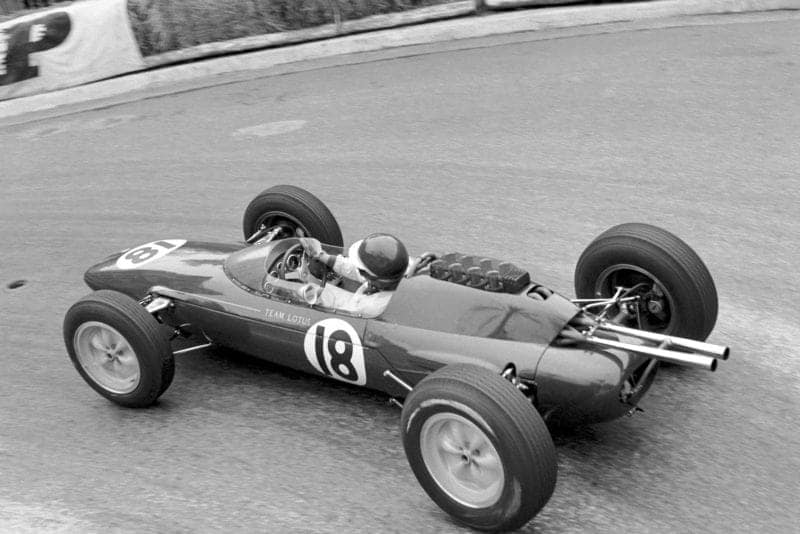
Clark put the Lotus 25 on pole
Motorsport Images
Jack Lewis came into his pit with petrol pouring from loose carburetter unions and Surtees came in with gearbox trouble on the Lola. The Cooper team were getting on quietly and efficiently with Wally Hassan and a Weber expert getting McLaren’s V8 engine sorted out, their Zandvoort gearbox trouble being overcome by making a larger-diameter input drive shaft. Nobody could approach Graham Hill’s time, though many were down in the 1 min. 36 sec. bracket, including Mairesse and Gurney, the 8-cylinder Porsche beginning to show the sort of performance that was expected of it. These two had recorded 1min 36.4sec, which equalled McLaren’s time, which the New Zealander had set up with little fuss. Team Lotus had all three works cars out and Clark tried them all, even to doing some laps in Taylor’s car without changing numbers!
The Lotus pit was terribly cluttered up with film stars and hangers-on and Jimmy was getting a little tired of it all. Shortly before practice was due to finish, with Graham Hill still holding FTD, the French TV people persuaded him to do a lap in the BRM to make some TV film, and while he was playing about doing this Jimmy Clark went out in the Climax V8 Lotus and made a new FTD and gained pole position on the grid. This little effort was more in anger than good driving, for he had become a bit short tempered with the cinema comedy. When Graham Hill stopped playing cinema he found he had lost his pole position! Who allows the TV and cinema people to infest the pit area, where some people were trying to take their racing seriously? And as for team managers who are not strong willed enough to say “—— off” . . . or perhaps they enjoy the diversion!
The timekeepers did their best to sort out all the times and decide which six “extras” would start, but they completely overlooked a 1min 37.0sec by Innes Ireland, so there was a certain amount of revising during the evening. The final sixteen are shown on the grid and the lucky six were Mairesse, Brabham, Trintignant, Ireland, Surtees and Salvadori. It was very hard on Siffert, who had done a remarkable 1min 38.9sec with his 4-cylinder Lotus, beating “invited” drivers Ginther, Taylor, Bonnier and Maggs, and Lewis who equalled Ginther’s works car time with his private BRM.
Race
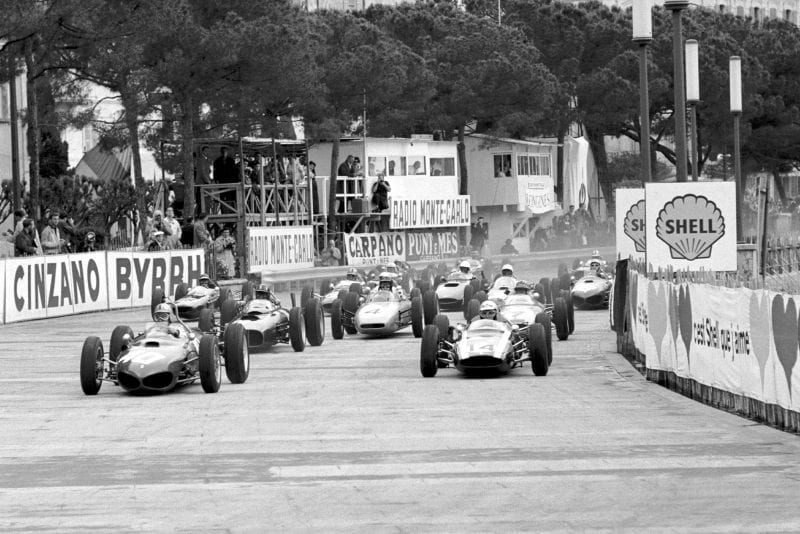
Ferrari’s Mairesse shot into the lead at the start
Motorsport Images
On Sunday while the cars were assembling at the pits the rain came down again, but as the time of the start approached the sun shone, a breeze blew and the road dried rapidly. The Team Lotus BRM-engined car was not yet right so Clark had the “monocoque” Climax V8 and Taylor the Lotus 24 with Climax V8. The gearbox on the new BRM works car had given trouble so Ginther was using the 1961/62 car, Graham Hill keeping to his regular mount; and the Ferrari team were all using the old-type 120-degree V6-engined cars.
By 2:45pm everyone was on the grid, all the engines were running, Louis Chiron was carefully counting-down, 30sec, 20sec, 10sec. At 5 sec he raised the flag and in a last-minute panic dropped it at the 3sec mark. Drivers had been warned that jumping the start would entail a 1min penalty (shades of BARC) so the early starting signal caught a lot of people on the hop. Not however Mairesse, for he shot through from the second row, collided with Clark and Graham Hill, who were a bit slow off the mark, and the Lotus jumped sideways about a foot and the Ferrari was through and heading for the Gasworks hairpin with a length or more lead.
“Mairesse stood on everything, got into a full-lock slide and uncontrollably slid past the apex of the hairpin and this caused a ‘chain-reaction’ that resulted in a complete shambles”
This terrific start meant that Mairesse arrived at the corner going much too fast and on the inside. He stood on everything, got into a full-lock slide and uncontrollably slid past the apex of the hairpin and this caused a “chain-reaction” that resulted in a complete shambles. Clark (Lotus), Hill (BRM) and McLaren (Cooper) were still in front-line order and seeing the red Ferrari sideways-on they braked hard, Clark almost coming to a stop on the inside. McLaren and Hill were quick to dive through, one on each side of the sliding Ferrari, towards the apex of the hairpin, and they led away up the back straight. Mairesse held his slide, got control and stormed after them, but behind there was chaos and confusion.
The unexpected heavy braking of the front-line caused those immediately behind to try to dodge, and Ginther (BRM) hit Trintignant (Lotus), who spun and collected Ireland (Lotus), who also spun. Ginther’s impact bounced him off the Lotus and his right rear wheel hit the back of Gurney’s Porsche. Meanwhile Trintignant hit the sea wall, spun back and landed up against the straw bales, Ginther went head-on into the bales and Ireland spun backwards into the bales, the rest of the field pushing and shoving their way round the corner and Taylor’s Lotus bending its nose cowling vertically upwards.
When the dust had settled Ginther’s car was minus a rear wheel, hub carrier, brake and drive-shaft, the whole assembly unfortunately having down over the bales and injured a marshal. Rob Walker’s brand new Lotus V8 was bent in all directions and derelict with its radiator torn right off, Gurney’s Porsche had had the rear of its gearbox broken off, and Ireland was realising that his Lotus-Climax V8 was not badly damaged and he drove to the pits to have a broken petrol pipe repaired, where Taylor was having his nose cowling broken off.
Ginther walked back to the pits, taking the blame for the mix-up as he thought his throttle had stuck open, but it was more likely an impression gained by the cars in front of him stopping more abruptly than anticipated. As if all this was not enough, Mairesse spun at the station hairpin and there was some more bumping and boring, this time without any more breakages.
There was a pretty mild old panic as the field came round the Tobacconist Corner, for the debris at the hairpin was still being sorted out, so that they all went by comparatively slowly, McLaren leading from G Hill, P Hill, Bonnier, Bandini, Clark, Maggs, Brabham, Surtees and Salvadori. Some time later a very deflated Mairesse arrived, followed by Taylor, while Ireland was still at the pits. The next lap was equally quiet, though Bonnier was put back in seventh place by Brabham and Clark, and on lap three the race began in earnest. Graham Hill began to close on McLaren, Brabham closed up on Bandini and Surtees and Maggs prepared to pass Bonnier, while Ireland had at last started racing, his Lotus looking a bit tattered around the tail but otherwise going all right.
It did not take Hill very long to catch McLaren and on lap seven the BRM came by in the lead with McLaren obviously having settled for a good second place. Clark was beginning to recover from the starting shambles and had passed Bandini, and Mairesse stopped at the Ferrari pit very briefly.
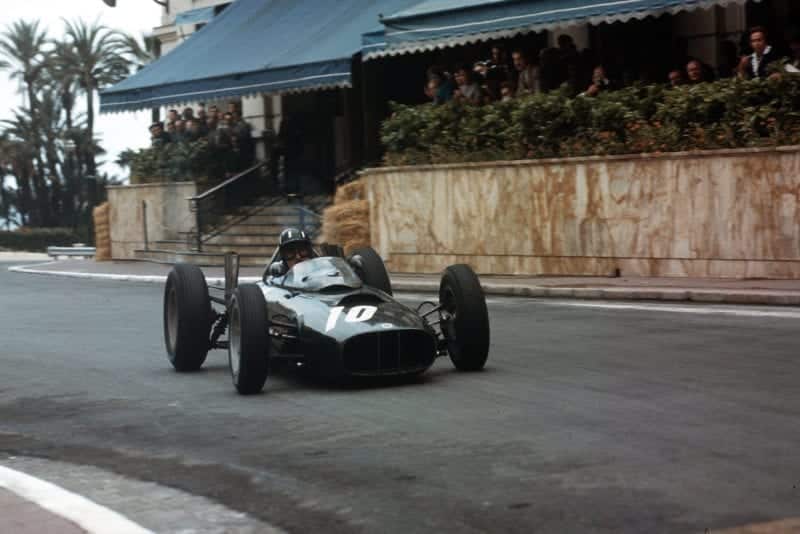
Hill snatched the lead on lap 7
Motorsport Images
At 10 laps Hill’s BRM led by nearly 3sec from McLaren’s V8 Cooper-Climax, with Phil Hill’s Ferrari 4sec behind, followed by Brabham (Lotus-Climax V8), Clark (Lotus-Climax V8), and Bandini (Ferrari). Already there was a long gap before Surtees arrived, followed by the rest of the runners, Mairesse being nearly a lap behind and Ireland bringing up the rear. Phil Hill was beginning to close up on McLaren and Clark was challenging Brabham and then on lap 12 the Ferrari team leader spun on the sea front and the two Lotus V8s of Brabham and Clark nipped by.
Apart from a few spots of rain falling nothing much happened up to lap 20, though Clark was obviously preparing to pass Brabham and take third place. This he did on lap 22, and by the way he stormed up on McLaren it was obvious that Brabham had been holding him back. Graham Hill was circulating serenely in the lead, now 7sec ahead of the works Cooper, but the danger now was Clark, who caught and passed McLaren with no trouble at all and began to set fastest laps one after another.
“Clark was now in a record-breaking mood”
At 25 laps, or quarter distance, Maggs, Bonnier, Salvadori and Mairesse had all been lapped, while Ireland was a long way back in trouble now with a leaking fuel tank. Taylor gave up at this point as he had an oil leak dripping on the pedals, and though pit stops had been made to try and stop the leak, and to mop up the mess, it was useless. At 30 laps the order was G Hill (BRM), Clark (Lotus), McLaren (Cooper), Brabham (Lotus), P Hill (Ferrari), Bandini (Ferrari) and Surtees (Lola), the remaining five runners being well behind.
Clark was now in a record-breaking mood, his gearbox working properly, whereas at the beginning of the race he was having trouble with gear-changing. In a remarkable series of fastest laps he made up the distance between his Lotus and the steadily and well-driven BRM in the lead. Graham Hill was well aware of the situation and with a new out-and-out lap record on lap 42 in 1min 35.5sec. Clark closed up to within 1sec of the BRM, but at that point Graham Hill kept him at bay.
This little bit of pressing on left everyone else way behind and meant that Bandini and Surtees were near to being lapped. On lap 45 there was still 1sec separating the works BRM and the works Lotus, which meant they were in sight of one another most of the lap. Surtees had just caught and was passing Bandini when Graham Hill came up behind, hotly pursued by Clark.
In the ensuing brief scuffle Hill made the most of the opportunity and got round the Tabac corner just in front of Surtees and Bandini, leaving Clark behind them, and wasted no time in getting down to the Gasworks Hairpin, braking really heavily, nipping round the corner and screaming away on lap 46, leaving Clark still looking for a way past the Lola and Ferrari who were racing for sixth place.
This little mix up allowed Hill to regain a lead of 6.5sec at lap 48, and this increased to 8sec on the next lap as Clark was now held up due to having to lap Ireland on the twisty part of the circuit. At 50 laps, which was half distance, Clark had not regained his former pace as he was in trouble with gear-changing again, and by lap 52 he had dropped back to 15sec, followed by McLaren, Brabham, Phil Hill, and now a lap behind the leader Surtees and Bandini.
Still running, but a long way back, were Bonnier and Mairesse, and Ireland was still in and out of the pits, being sick from petrol fumes at the same time. Clark’s trouble was more serious than mere gear-changing problems and on lap 56 he came to rest out on the circuit with a broken clutch.
The impending rain was mercifully holding off and Graham Hill was now completely unchallenged, but his American namesake was getting very close to Brabham, having been closing the gap foot by foot for many laps. As the BRM went through the Casino square McLaren’s Cooper V8 was rounding the Gasworks Hairpin and Brabham was taking the chicane on to the harbour front, with Phil Hill close behind. These four were the only ones on the same lap, Surtees and Bandini being just one lap down on the leader, but not yet being caught by McLaren.
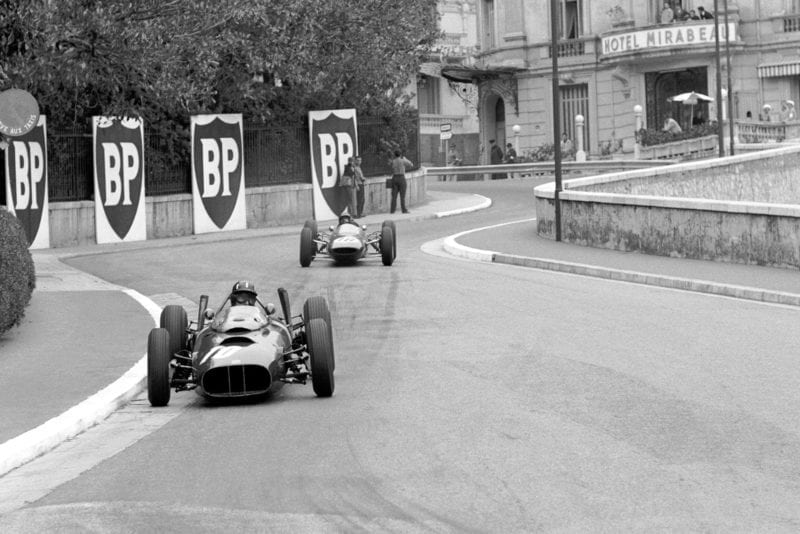
Hill spent a large part of the race under pressure from Clark
Motorsport Images
Having taken the advantage of lapping slower cars to get rid of Jimmy Clark, the situation was now bouncing back on Graham Hill, for no longer being challenged for the lead he wanted to ease off a bit, having 45sec lead, but the moment he eased off he had Surtees right on his tail, with Bandini close behind. Behind this awkward situation Phil Hill got right up to Brabham’s tail and then overdid it on a corner and dropped back to a 5sec gap, courageously starting to catch up all over again.
The leader’s situation was getting desperate for the BRM engine was beginning to blow smoke from its breathers and Hill badly wanted to ease the pace a bit, but always Surtees was right behind and pushing hard; he had to for Bandini was closing on the Lola and was obviously going to have a go at regaining fourth place. Graham Hill had let his lead drop to 36sec and meanwhile his namesake had re-caught Brabham and this time made no mistake and took third place on lap 76.
“Brabham lost it going round the Casino square and went off the road and up a grass bank, digging a great lump out of the Royal turf”
The Australian Lotus driver was looking very hot and tired, and had been so for many laps, while Phil Hill was looking beautifully calm and confident. On lap 77 Brabham “lost it” going round the Casino square and went off the road and up a grass bank, digging a great lump out of the Royal turf. Although he was able to drag the Lotus back onto the road and restart down the hill to the Mirabeau, his race was run for the front suspension was bent and he limped slowly round to the pits to retire.
The position of the leader was now precarious and, tired of the pressure of Surtees and Banditti, Graham Hill let the Lola by, but after only three laps of being between the duelling Lola and Ferrari he had lost 4sec to McLaren and now had only 30sec lead. This situation was not good so Graham re-passed Surtees on lap 84, the BRM smoking even more, but all this messing about meant that McLaren was now only 28.5sec behind, and meanwhile the Ferrari pit, seeing that Phil Hill was well wound-up, gave him the “flat-out” signal, which told him to give the Ferrari all it had got and if it blew up the pit would take the consequences.
The position of the BRM now looked anything but confident and on lap 87 Bandini was right behind Surtees’ Lola. As they rushed down to the Gasworks Hairpin Bandini made up his mind, raised a hand as a signal to the Marshals, and Surtees if he was looking in his mirror, and leaving his braking extra late he dived through on the inside and chopped Surtees off just as he was going to lock over for the hairpin. It was as neat a piece of forceful Grand Prix driving as one could want to see, and looking completely relaxed and confident Bandini accelerated away from the hairpin in fourth place, snicking through his 6-speed gearbox with some splendid gear-changes.
On lap 90 Graham Hill had only 26sec lead over McLaren and next time round there was obviously something wrong for he was back between Banditti and Surtees and, as the BRM went past the pits heading for St Devote corner a rough note came into the V8 exhaust note. He came round again but BRM supporters had their fingers crossed, and as the car went up the Hill to the Casino it was obviously sick. Poor Graham Hill got as far as the Mirabeau hairpin on lap 93 when there was a bang from the engine and he coasted down to the Station with oil pouring from the underside of the car.
As he got out, McLaren rounded the hairpin to take the lead and a few seconds later Phil Hill charged by, thrashing the Ferrari V6 engine for all he was worth. An agitated Cooper pit was keeping McLaren informed of the situation but the young New Zealander was as calm as ever, knowing just how he stood and not getting flustered.
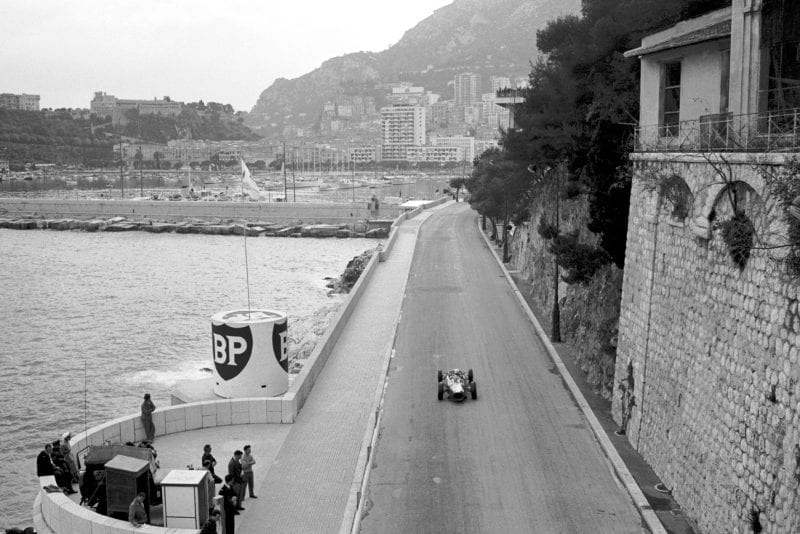
Seen here running on his own, Hill eventually closed up to within 1.3sec of McLaren
Motorsport Images
At 95 laps, with only five to go, the charging Ferrari was 12sec behind the very healthy Cooper-Climax V8, the next lap 11sec, then 8.5sec, then 7sec, and the Ferrari supporters were going wild, and the rest were waving McLaren on excitedly. As they finished lap 99 there was only 5sec between the Cooper and Ferrari, but McLaren was smiling quietly to himself for he was quite confident that even if Hill did chop off 5 sec on this last lap he still had to get past.
In a splendid display of self control McLaren finished the last lap with the red Ferrari in full view in his mirrors, only 1.3sec behind, but 0.3sec would have been enough. Phil Hill’s efforts had been more than worthy of the World Champion, and the Ferrari engine had more than proved its strength. In third place, on the same lap as the winner, was Lorenzo Bandini, no mean feat on the twisty Monaco circuit after 100 laps, and the young Italian had driven an excellent race, looking calm and unruffled at all times. Surtees was fourth just over a lap behind the winner, and trailing round at the end came Bonnier in the old Porsche, completely lacking in front shock-absorbers. Mairesse had kept going until lap 90 when he managed to switch off just before the engine burst, and he coasted into the pits to retire.
Monte mumblings
- The Cooper victory put renewed vigour into Grand Prix racing, as did the unfortunate blow-up of the BRM. There are those who have taken great heart from the fact that the BRM engine is not infallible and that Coopers are by no means the back number they looked like being.
- The first corner pile-up was unfortunate but it would be difficult to place the start anywhere else on the tight little circuit.
- Jimmy Clark’s new lap record 1min 35.5sec was really something and showed that if a top driver tries hard he can easily prove that Grand Prix cars get better and better, which is progress.
Space does not permit a report on the junior race, run in two Heats and a Final for the first 11 in each Heat, but some random comments may be of interest. Arundell stands out as ready for upgrading, as Clark did two years ago, his driving was neat, relaxed and fast, unlike some junior drivers who are positively untidy. It would seem that one cause of Junior race crashes is due to many drivers having complete disregard for entering a corner on the right line, there being as many varied lines as there are Junior makes. The driving of Ryan, the Canadian, and Spence, both in Ian Walker Lotus-Juniors, was very impressive, while Bardi-Barry the Austrian driver did extremely well to finish fourth in the Final; in the first corner pushing match another competitor jumped completely over Bardi-Barry’s Cooper, leaving him dazed and bewildered and completely stationary, joining in long after the rest of the field had gone. The race between Cowles and Rosqvist for ninth place went on for the whole Final -and they were so worked up that they crossed the line side-by-side and flat out, both crashing into the straw bales at the hairpin, going much too fast to stop. The performance of the Italian Wainer-Ford was good, it being a good copy of a Lotus 22; if you must copy it pays to copy a good design! The driving of Richard Attwood in the Midlands Partnership Cooper was of a very high standard, it was a pity the car broke when he was so well placed.
